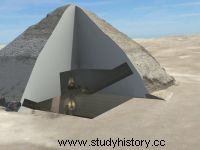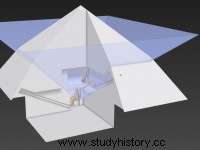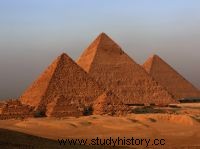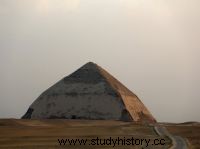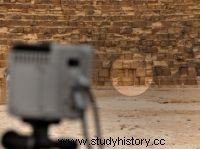These particles can cross very thick rocks. In Egypt, the ScanPyramids campaign uses them to X-ray monuments in depth and reveal previously invisible structures.
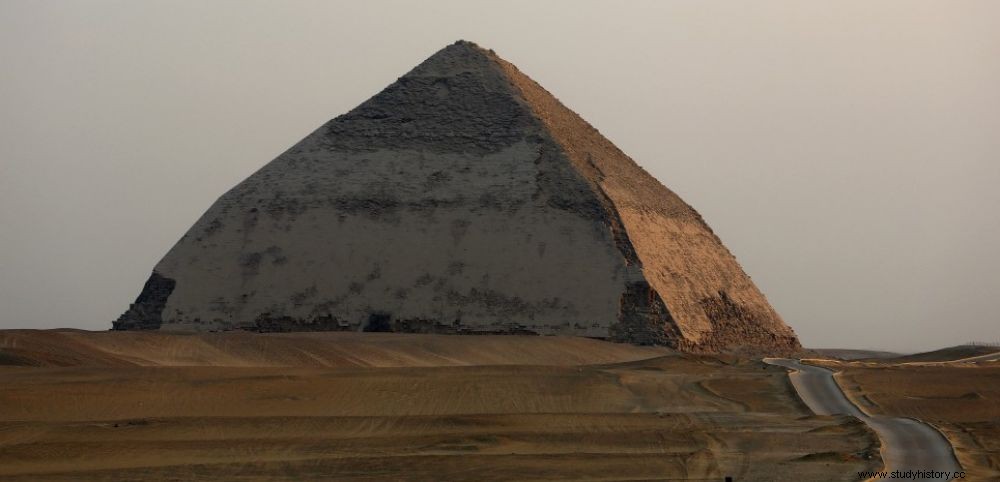
The Bent Pyramid of Dahshur, Egypt.
FUTURISTIC. The image is worthy of a science fiction film:a line of men dressed in white coveralls, their faces covered with masks, climb a pyramid, and enter a narrow and dark gut. These outfits, while impressive, are really just dust protection. But the mission of these men is far more futuristic. Because it's about capturing cosmic rays in the heart of a 4000-year-old funerary monument! This first week of December 2015, the second phase of the ScanPyramids mission has just begun. Launched in October by the Faculty of Engineering in Cairo and the French Institute HIP (Heritage Innovation Preservation), this international mission, bringing together Egyptian, Canadian, French and Japanese teams, aims to implement the most innovative ways to probe the heart of the great funerary monuments of the 4th dynasty:Kheops and Khephren on the Giza plateau, the Bent Pyramid and the Red Pyramid at Dahshur.
IN IMAGES, IN PICTURES. Muons explore the pyramids
The first phase, a short infrared campaign, is already a success since it has revealed anomalies in all the pyramids, including a particularly spectacular one on the east face of Cheops. It is now a question of installing muon sensors in buildings, these cosmic particles coming from the upper layers of the Earth's atmosphere, which permanently bombard the Earth. Like the X-rays that pass through our body and allow us to visualize our skeleton, these kinds of heavy electrons, capable of crossing very thick rocks, will make it possible to radiograph monuments in depth. And to reveal structures hitherto invisible.
The presentation video on what the ScanPyramids mission will be in 2016.
ScanPyramids in 2015... To be continued in 2016 from HIP Institute on Vimeo.
The films of the rhomboid will be developed and analyzed from January 2016
In November 2015, the team of Professor Kunihiro Morishima, from the University of Nagoya, carried out tests in the rhomboidal pyramid of Dahshur, in order to calibrate the sensitivity of the emulsions used to detect muons. They managed to capture images. A first ! Because the previous mission of this kind, carried out in the 1960s by the Nobel Prize in Physics Luis Alvarez – a visionary for the time! – had not been conclusive. The Japanese were also able to determine the ideal exposure time for films. Information that made it possible to launch the muons campaign.
"SANDWICH". Forty plates each containing 2 films sensitive to cosmic particles and representing a total surface of 3 square meters have therefore been placed in the lower chamber of the rhomboidal pyramid. In addition to these "classic" plates, the ScanPyramids mission team installed two others, made up of a "sandwich" comprising, one seven lead-based films, the other four tungsten-based ones. Their role:to absorb low-energy particles to retain only the most powerful, in order to eliminate any "background noise". These control plates will be used to optimize the analysis of the other 40. "At the same time, we installed test sensors in the so-called "Queen" chamber of Kheops, in order, once again, to calibrate them as well as possible according to the interior environment before completing the installation in early 2016" , specifies Mehdi Tayoubi, co-director with Professor Hany Helal of the ScanPyramids mission.
The films of the rhomboid will be developed and analyzed from January 2016, in Cairo and in Japan. What revelations should we expect? The ScanPyramids team refuses to make any assumptions. But like all great pyramids, the building has its share of mysteries. It is undoubtedly, after Cheops, the one whose structure is the most complex:two entrances, one to the north, the other to the west - a unique case for these monuments - leading to two funerary chambers located one above each other; and a high well, at the central axis, whose function is unknown. Some specialists, including the great Egyptian archaeologist Ahmed Fakhry, now deceased, imagine that it still hides, in its massif, corridors or rooms not yet detected.
IN IMAGES, IN PICTURES. In the bowels of the Egyptian pyramids

